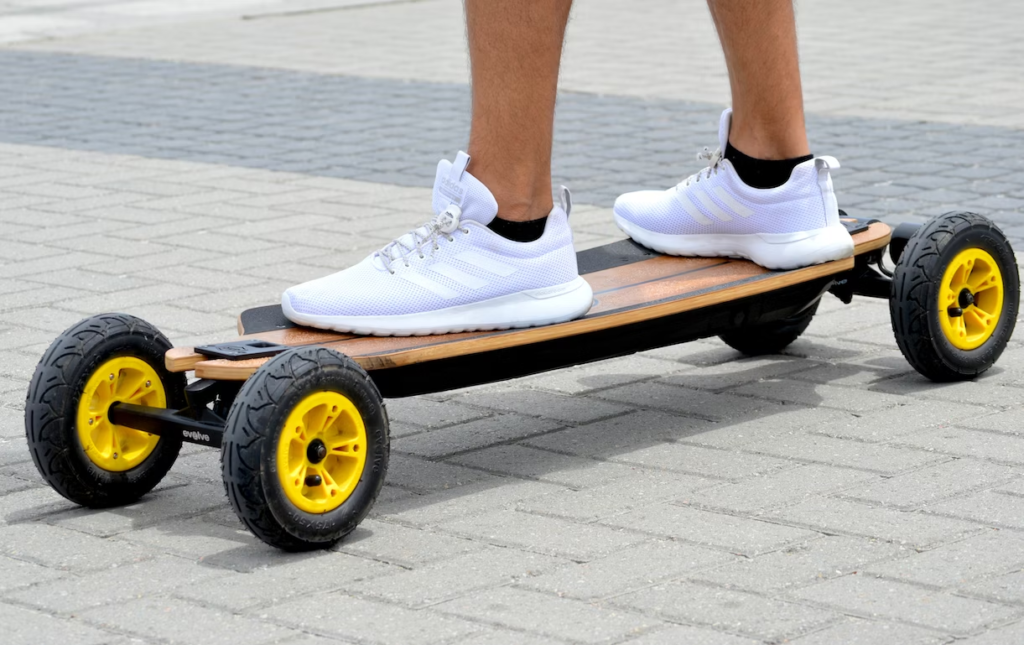
Can I Ride My Electric Skateboard In The Rain?
No, it does not. Many manufacturers say that their electric skateboards are waterproof, but they don’t inform you that they are only partially waterproof.
Many companies that make electric skateboards say that their boards are waterproof. In reality, no such thing as a board is entirely waterproof. Most panels are only water-resistant, so you can’t ride them in the rain (unless it’s just a light drizzle).
Wet roads are only sometimes a good place to ride an electric skateboard. When the ground is wet, it is tough to walk on. When depending on wet streets, you should also be careful when you speed up or slow down because your board will likely slip away. If you’re just starting out, don’t ride in the rain or when it’s wet.
Riding a backfire electric skateboard in the rain
You can’t use the board when it’s raining when the ground is wet or icy, or if you put it in water. Water can damage your battery and your ESC, motors, deck, and wheel bearings. We don’t cover water damage under our guarantee; almost no other company does.
Backfire boards are waterproof in some ways. It might be safe to ride in small puddles. But the board will need to be dried.
But never put your board underwater or ride it over water already there. An intense rainstorm is also not a good time to ride your board.
More water can help your board. The insurance doesn’t cover water damage, which is too bad. And if water damages your board, it could cost a lot to fix.
- Still, if you have to ride in the rain, make sure it is manageable and continues as you ride.
- When you get home, clean your board immediately with a dry cloth and keep it in good shape.
- You can also use the remote to spin the wheels to get water off the board.
Read:
How Long Does It Take To Learn To Skateboard? – Techniques And Benefits In 2024
How water affects an electric skateboard?

Over time, water damage to the electronics on an e-skateboard can make it less safe and less effective. Moisture can cause brief problems with how parts connect or fit together.
- Water can hurt lithium-ion batteries, shortening their life or making them less effective. When water gets on battery leads or seeps into battery cells, this is called rust. If the battery has a high charge, there is also a greater chance of getting an electric shock if it gets wet. It’s best to ensure the battery is fully waterproof or to avoid putting it in water if you can.
- Water makes it possible for electricity to move, which can cause the system to have short circuits. This increases the chances of a fire, broken parts, and losing control.
- If water enters an electric motor, it can damage the insulation, bearings, and other parts. This could make the motor stop working, shake or squeal, or need to be replaced. Most sealed motors have some sort of seal, but submerging or exposing them to too much wetness can be dangerous.
- Engine processors control how much power goes to an electric engine. Water can damage the controller’s wires, cutting or reducing strength. Some controls are less likely to get wet than others, so the risks depend on which parts are used.
- Bolts, nuts, battery connections, and other metal parts can rust when covered in water or left wet for a long time. Over time, the rust makes the structure less stable and unable to carry electricity. Corrosion prevention helps prevent problems, but it may not eliminate them entirely.
- Some e-skateboards have features like cruise control, speed limits, and balance control that use sensors. Water can break these sensors, which can affect the functions that depend on them. Not all boards have sensors, so this risk relies on how your model is made.
In the worst cases, water can cause lasting damage by corroding wires or making parts stop working. It’s best to take steps by closing and protecting devices when possible and not putting pieces in water. Water could still get in and cause problems even if you cover something.
Making a skateboard waterproof

1. CLEAN THE BOARD
Start by giving your board a wipe-down with warm water, a soft brush, and a light cleanser. This will help eliminate any dirt, dust, or other things that could get in the way of sealing. Then, put a layer of waterproof sealer on the board’s surface.
For the best results, follow the directions on the sealer bottle. After the sealant has dried, you’re ready to hit the waves.
2. USE A WATERPROOFING SPRAY
After you’ve cleaned your electric skateboard, it’s time to use a waterproofing spray. Paint the board’s sides evenly with a paintbrush or roller.
3. USE WATERPROOF TAPe
Now it’s time to use waterproof tape surrounding the edges of your board. This will add an extra layer of defence against damage from water and moisture. For the best results, follow the directions on the tape box.
4. Polish THE BOARD
After you’ve put the waterproofing spray and tape on your electric skateboard, it’s time to wax it. This will make a protected layer that keeps water and wetness away from your board, keeping it in great shape. To put the wax on the board, wait for it to dry before your next ride.
5. YOU ARE NOW Set TO RIDE
Now that you’ve finished making your electric skateboard waterproof, you can take it out on the streets and enjoy your ride. Clean it often and wax it every few months to keep it looking its best.
Read:
Is Skateboarding A Hobby? – Fact Explained In 2024
How to keep your electric skateboard in good condition after using it in the rain?

To keep your e-skateboard in good shape, it’s essential to take the proper care after going in the rain. Here are some crucial steps:
- Rinse the board and let it dry all the way. Hubs, pulleys, sensors, zip ties, etc., can be cleaned of water with water, rags, soft brushes, air blowers, and heat guns. Let everything dry completely before riding or putting it away.
- Pulleys and other moving parts need to be cleaned and oiled. Use grease to ensure that gears on wheels, bearings on pivot points, links, and other factors can move freely. This keeps parts from squeaking and makes sure they move smoothly.
- Check for damage and fix it. Before you ride again, check for signs of water damage or rust and repair or replace parts as needed. Also, check the state and pressure of the tires and add air if needed.
- If necessary, take the parts apart and dry them. For boards that are very wet, it’s best to take out details like the motor driver and let everything dry. Before you ride again, put everything back together to avoid problems in the future.
- Use something to stop rusting. In very wet or salty environments, use a corrosion agent or lube on metal parts like wheels, pulleys, and bearings to keep them from rusting. In damp weather, reapply after each ride.
- Think about the future. Install extra seals, covers, and water-resistant finishes to protect parts better when going in the rain. The best way to deal with something is to stop it from happening in the first place.
Some pros and cons of an electric skateboard

Pros:
1. Easy to pick up and ride (several ways to ride)
Is it easy to learn how to drive and use an electric skateboard? Yes, it’s not hard at all. Electric skateboards have settings for beginners, regular use, and advanced use.
Beginners should use “learner mode” to ensure they have the least amount of power and a slower rate of movement. This will comfort people and help them learn how to control the speed with the remote control.
2. Wireless controls you can hold in your hand make driving easy
The electric skateboard has a monitor built-in and Bluetooth to connect it to the remote control. Just by hitting a button, the user can change the speed and how fast it goes.
A thumb wheel, and wireless remote control, can help you ride easily and keep your attention on the road so you don’t have to push. This makes learning how to ride a skateboard more fun than using a regular one.
3. Brake with a generator
These run on batteries, so they need to be charged again when they run out of power. So that the battery lasts longer than it can handle, the maker of the electric skateboard system makes it so that electricity is created when the board is stopped.
Renewable energy lets the system run longer, especially in areas with uneven terrain.
4. Fast and lasts a long time
On flat ground, an electric skateboard can go as fast as 25 miles per hour at its fastest. This is a breakneck speed, and driving 20 miles in more than an hour is easy. Some skateboards can go farther, depending on the person’s weight.
Cons:
1. Weight
An electric skateboard is a lot bigger than a regular one. Because electric skateboards have motors, brake pads, and batteries built in. Because of this, it is not very easy to carry.
2. Max weight
Almost anyone can use regular skateboards, but these electric forms are better for lighter people. The highest speed a significant person can hit will be much lower, the average range will be much shorter, and if the battery is used up too quickly, it will die soon.
3. Expensive
Most electric skateboards range in price from $200 to $1,000. Even the least expensive electric skateboards cost a lot more than regular skateboards. This is a lot of money if you want better electric skateboards.
4. Have to pay
When you ride an electric skateboard a long way or for a long time to get somewhere, finding a place to charge it may take a lot of work. The electric skateboard can be ridden without power, just like a regular skateboard, but it will wear you out more quickly because it is more extensive.
5. Harder to keep up with
Electric skateboards are more complex and have more electric parts than regular skateboards. Once it’s broken, it will be harder to fix. If you change the parts with new ones, it will cost you more money.
Read:
What Are A Skateboard And Scooter Called? – The Correct Terminology You Should Know 2024
Summary
Riding when wet is very dangerous because the roads are slippery; you also get wet and dirty when you ride. Even though riding an electric skateboard in the rain or other damp weather is possible if you take the proper measures, the rider must be extra careful and aware.
By knowing the risks of water damage and less grip, preparing your board for dangerous conditions, wearing the proper safety gear, and keeping your board in good shape after riding in the rain, you can lower the risks of riding in the shower.
But there is always a risk when riding a skateboard in the rain, even if you take all the proper steps. Use your common sense to decide if riding is safe based on things like how well you can see, how hard it is raining, how wet the ground is, and how well you know how to ride.
If you are worried about how the weather might affect your health, safety, or gear, it is best not to ride.
FAQs
Q: How many years do electric skateboards last?
1-3 years.
Q: Is there any electric skateboards that are waterproof
A: Here are some excellent waterproof electric skateboards:
- MaxFind Max 4
- Enertion Raptor 2
- Blizzard Hurricane
- Skatebolt Tornado
- WowGo 3
- Evolve Carbon GTR
- Boosted Plus
- Meepo 3
- OneWheel
- Onboard Mini KT
- Jedboard AWD
- Inboard M1
Q: Are electric skateboards dangerous?
Electronic skateboards are more dangerous than regular skateboards because they use Lithium-ion or Lithium-Polymer batteries.
Q: Should I get an electric skateboard? Why?
If you like board sports like surfing or skiing but want the right weather to have fun, an electric skateboard is for you.
Video guide
Read Also
- Can You Put Clear Skateboard Grip Tape On Your License Plate? – Complete Guide 2023
- Is Skateboarding Harder For Girls? – Crushing Barriers In 2023
- Can You Use Skateboard Wheels On Roller Skates? – Advantages And Disadvantages In 2023
- Wooper On A Skateboard – An Unforgettable Ride 2023
- Heath Ledger Skateboard – Unraveling The Actor’s Skateboarding Journey 2023
- Can You Skateboard In Seoul? – Everything You Need To Know In 2023






